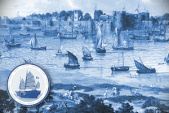II.4 The Arabian Seas: Malabar, Gujurat

Surat served as the headquarters of both the English and the Dutch East India Companies for their trading operations in north-western India and around the Arabian Seas. The city held its position of prominence in the Indian Ocean maritime trade until the end of the eighteenth century. On the Malabar Coast, Calicut was the most prominent centre of maritime trade in the early modern period.
The Portuguese settled in Goa in 1510 and expanded their influence along the Malabar Coast, a pepper-producing area. One of the Portuguese towns, Cochin, was conquered by the VOC in 1663. Several smaller strongholds on the Malabar Coast served as military observation posts which monitored pirates and ‘smugglers’. Most of these were small Indian traders striving to avoid the European pepper supply contracts. The rajas of Cochin and Calicut often made lucrative contracts with the Dutch to deliver pepper from their hinterlands. The Daily Journals of Batavia contain some letters from these rajas. The rise of Travancore in the south eventually led to a decline in the pepper supply to Europeans in the late eighteenth century.




